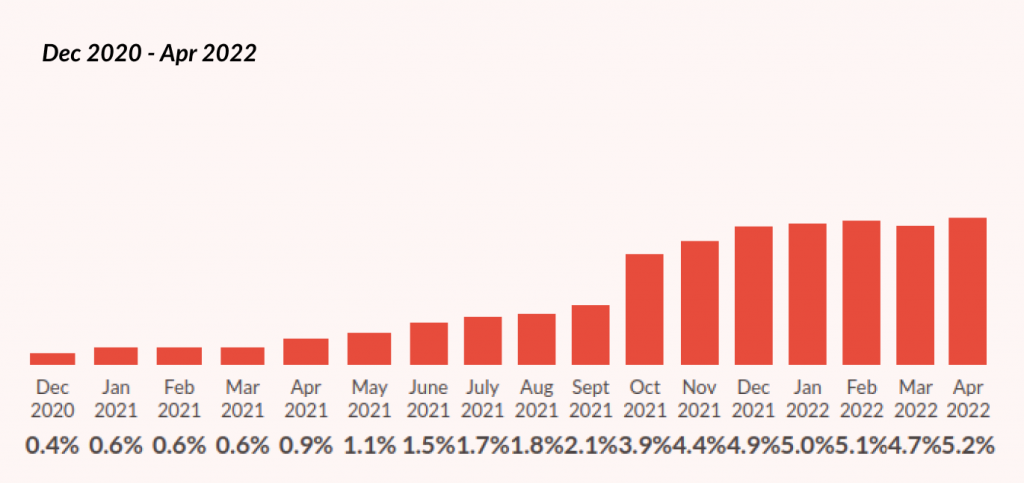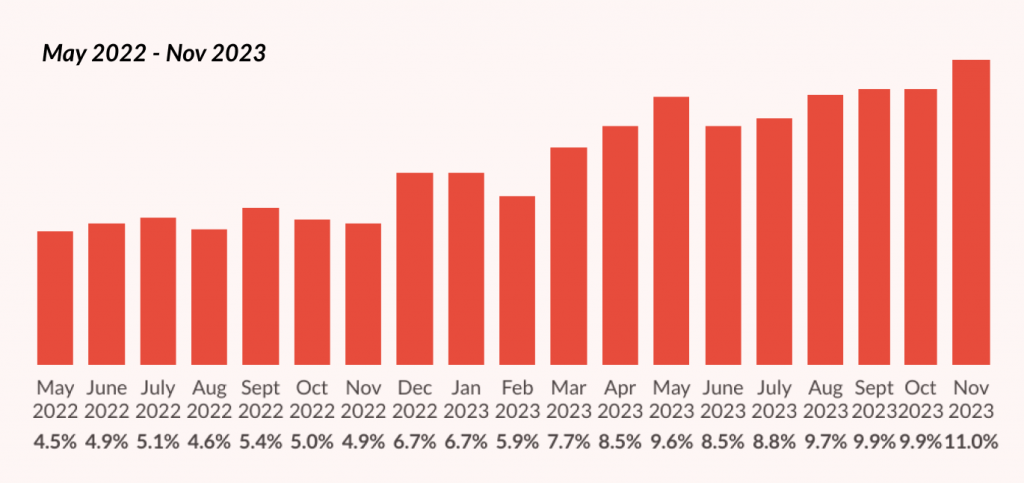We email marketers love new tech to play with, yet there are only so many hours in the day. But new tech also has a tendency to get headlines. And headlines tend to make you feel like everyone is doing it. And when everyone is doing it...well...marketing FOMO tends to kick in.
One of the handy things about building a competitor email tracking platform like SendView, though, is that we have A LOT of data. Our users have analyzed statistics around millions of campaigns sent via hundreds of ESPs for things like:
- Email volume
- ESP popularity
- Word/emoji/etc usage
- Spam scores
- Day of week trends
- Time of day trends
- Adoption of coding practices
As you might have guessed, dark mode usage is one of those coding practices we track. And as you also might have guessed, those statistics are exactly what we're going to explore in this post.
The Beginning: Slow, Fast, Slow
According to Litmus, dark mode became in thing in 2018 (for Apple) and 2019 (for iOS, Gmail, and others). At the tail end of 2020 we started flagging it in the system and building reporting around it. When we say "flagging" we simply mean that as we analyze the emails in our system we are looking for specific types of code that are used to optimize an email for dark mode. For example, one of the ways to enable an email campaign for dark mode and then optimize that template to render well when dark mode is enabled is using a CSS media query called "prefers-color-scheme: dark" so, among other things, we look for different variations of that.
So, when we looked across all those email campaigns, here's how those dark mode usage statistics look for the 17 months following Dec 2020.

This was the first update we posted and, as we look over these statistics, three distinct periods jumped out.
Dark Mode Adoption, Phase 1: Slow (Dec 2020 - Summer 2021)
The first phase is one of slow but fairly steady adoption of dark mode code. In Dec 2020, 0.4% of emails we analyzed were optimized for dark mode. Three months later that statistic had only risen to 0.6%. As summer 2021 came along, we saw that number rose again to just over 1.5%. Yes, that's triple what it was in Dec 2020, but it's still only about 1 of every 60-70 email campaigns.
In other words, dark mode was still a fairly niche coding technique that a small group of marketers were spending time building templates for. That said, it was showing promise that other email coding trends hadn't seen.
Dark Mode Adoption, Phase 2: Fast (Fall 2021)
For whatever reason, dark mode had a bit of a moment in the fall of 2021. Specifically, between September 2021 and November 2021 where the number of campaigns that were optimized for dark mode shot from 2.1% to 4.4%. December saw another decent uptick as the percentage rose 0.5 percentage points to 4.9% of all campaigns we analyzed.
What drove dark mode usage stats to spike like this? From my research, it looks like fall of 2021 coincides very closely with a surge in email influencers and blogs not just talking about dark mode but actually breaking down best practices, sharing step-by-step guides to implement it, and giving this trend a lot more legitimacy and practical knowledge than it had previously seen. Said another way, dark mode became something that was becoming more accessible to the general email marketing public.
Dark Mode Adoption, Phase 3: Slow (Early 2022)
After this spike, however, things didn't change much for the following few months. By April of 2022, 5.2% of all emails we analyzed contained dark mode code, a 0.3 percentage point increase from Dec 2021. This trend did break the 5% barrier, but only just.
I remember refreshing the stats around this time and being really surprised. We really thought that dark mode had the momentum, knowledge sharing, and momentum to keep that upward trajectory going steady. So at the time this left us wondering whether this plateau going to continue or if dark mode adoption would fine a way to break through that ceiling and once again begin to rise,
The Latest Dark Mode Usage Status: Onward & Upward
In the 18 months since that update, the adoption of dark mode code, at least based on our data set, as seen very solid growth. Yes, there are some ups and downs along the way, but the trends is strong and consistent overall. Here's a chart showing how many emails contained dark mode code between the months of May 2022 and Nov 2023.

But even this chart shows two parts. To avoid confusions with our reference to Phase 1, 2, 3 above, we'll call these Phase 4 and Phase 5.
Dark Mode Adoption, Phase 4: Slow (Rest of 2022)
We wondered if the plateau we saw early in 2022 would continue and continue it did at least momentarily. The highest point between May 2022 and Nov 2022 for dark mode adoption was September where 5.4% of emails we analyzed included code targeted at dark mode styling. But of those 7 months, 4 of them were below 5.0%. Dark mode adoption just didn't seem to be able to gain consistent momentum and it was unclear whether email marketers were randomly trying dark mode or whether there was a bit of trial, church, trial, churn happening that led to the roller coaster during these months.
Finally in Dec 2022 and Jan 2023, the number shot up to 6.7% which gave us hope it was once again on the up and up, but the next month dark mode usage was back down to 5.9% in February of 2023.
Dark Mode Adoption, Phase 5: Onward and Upward (Most of 2023)
Since February of 2023, however, there has only been one month that saw fewer dark mode optimized campaigns than the previous month. And during that time we've seen dark mode code usage go from 5.9% of all campaigns to, so far in Nov 2023, 11.0% of all campaigns. As I mentioned, we expected this number to rise but the size of that number surprised us. Seeing any email technology break 10% adoption is a huge milestone.
Now, we're writing this around the Thanksgiving holiday so that monthly average may change a little before we hit December, but even still it's impressive to see that now nearly 1 out of 10 emails we're analyzing has some amount of code to help that email be optimized when dark mode is enabled. Dark mode is here to stay and, at least in my book, it's simply a matter of high these statistics will rise and how quickly that will happen.
The Future of Email and Dark Mode
So what is driving this increase in usage? It's tough to say, but if I had to put my money on one thing it would be the fact that email creation platforms like BeeFree now have ready-to-use, dark-mode optimized templates. It's easy to think that education around dark mode has driven more email marketers to dig into their code to improve how their campaigns render, but it's just as easy to forget that the vast majority of email marketers are not on teams that have the skills, bandwidth, and resources to be writing code themselves.
If there is a simple, turnkey way for them to use this sort of code? Yeah, that's something they can entertain. Which means that the plateau we saw in 2022 and early 2023 might simply be a reflection of the fact that adoption had been maxed out among the "write your own code" crowd and it wasn't until more nocode solutions came along everyone else could take advantage. And perhaps it was that tipping point that started the trend in the upward direction again.
Before that happened, though, dark mode had to gather enough momentum in both usage (from the hard coders) and knowledge (by the experts and thought leaders) to be worth of making the roadmap of tools that would make dark mode available to the rest of us. Gmail Annotations hasn't managed to do that, AMP is similar, but dark mode had the right combination of lift and value to work.
And maybe this is a lesson for the teams that are trying to drive adoption of new marketing tech: if you want adoption to grow beyond the group of hardcore email coding folks, you've gotta make it easy for everyone else to implement even if they don't have the skills of that core, email marketing community.
How high will dark mode adoption go?
As long as normal email marketers can either add dark mode styles to an existing template or choose from a growing list of templates that are dark mode ready, I think rapid growth will continue. A decade ago responsive emails were still an uphill battle, but today? They're nearly ubiquitous. Same goes for things like DKIM and SPF that were once a painstaking, manual process but are now an fairly easy step of virtually every ESP's onboarding process.
Which means in the long term I don't see why this number couldn't one day find itself well north of 50% in the "majority" category of all emails, but over the next couple years I wouldn't be surprised to see it reach 20-25%. Is 100% possible? I suppose so, but given that there's another trend behind the trend - the demand for dark mode settings in general - there are likely a few factors that could derail dark mode's ascension into the realms of other email trends.
My batting average on predictions is dubious at best, though, so I think we'll just circle back in 2024 and see what the data says.
P. S. Curious how many of your peers and competitors are optimizing their emails for dark mode? SendView can answer that any many other questions. Patrick and I would be tickled if you gave it try.


 Gregg Blanchard November 28, 2023
Gregg Blanchard November 28, 2023